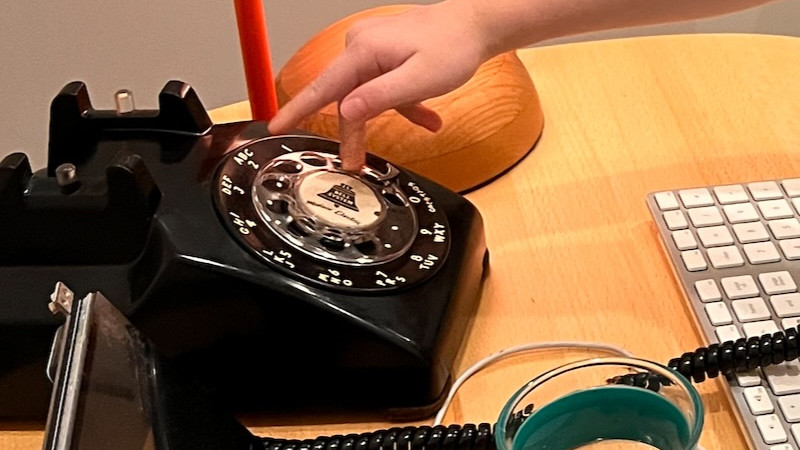An endless source of amusement for those of advancing years can come from handing a rotary phone to a teenager and asking them to dial a number with it. It’s rare for them to be stumped by a piece of technology, after all. [Mnutt]’s 4-year-old son had no such problems when he saw rotary phones at an art exhibition, so what was a parent to do but wire the phone to an Asterisk PBX with shortcut numbers for calls to family and such essential services as a joke line, MTA status, or even a K-pop song.
It’s possible to hook up a pulse dial phone with a SLIC module and a microcontroller, but in this case, a Grandstream SIP box did the trick. These are all-in-one devices that implement a SIP client with a physical connection, and older ones will talk to pulse dialers as well as the more usual tone dialing phones. The phone in question is a vintage American model. Writing this from Europe we were surprised to find a little simpler inside than its transatlantic counterparts of the same era.
An Asterisk install on a Raspberry Pi completed the project, and thus it became a matter of software configuration. It’s a useful run-through for Asterisk dilettantes, even if you haven’t got a 4-year-old. Perhaps you have an old payphone or two!















All Grandstream ATA boxen support pulse dialling, but you may have to enable the support on their HTTP control interface
Yes I can use a Grandstream 802 and works perfectly with Sipgate. However just signed up to Community Fibre in London and they supply a Grandstream but locked with pulse dialling not activated and so unable to change. How stupid are these people.🤷
Yup! Have an old Soviet-made rotary phone connected to a Grandstream ATA and my VoIP service. Works great!
Also: classicrotaryphones.com/forum
Nice product placement in the non-stock photo!
Ersten Electric model 500 sales about to go through the roof!
Funny comment ruined by stupid autocorrect.
SLIC = Subscriber Line Interface Card (not Module).[1]
“Grandstream SIP box did the trick. These are all-in-one devices that implement a SIP client with a physical connection, and older ones will talk to pulse dialers as well as the more usual tone dialing phones.”
The correct name for that device is a Voice over Internet Protocol Analog Telephone Adapter or VoIP ATA.[2] VoIP ATAs are the most cost effective way to connect one or a few subscriber stations (analog telephones) to a VoIP Private Branch Exchange (VoIP PBX).
Another approach, especially when you need to service many analog telephones (assuming they are Dual Tone Multi-Frequency [DTMF]) Dialing, is to use one or more multi-channel Foreigm Exchange Station (FXS) PC card(s).[3]
The project builder said, “I would have been able to attach the Grandstream adapter directly to the machine running the Asterisk server. But for the equipment I had, I ended up attaching the Grandstream to the Raspberry Pi in my son’s room, and having it bridge wifi to an old server under my desk running Asterisk.”
I don’t understand that. A Raspberry Pi 4 or 5 can run the whole thing; the Asterisk VoIP PBX, PIPER Text-To-Speech (TTS), et-cetera. Just try to avoid using aggressive voice CODECs like G.729 (CS-ACELP; 8kbit/s); the G.721 (superseded by G.726; 32kbit/s) CODEC is a good choice.
Hey, just for fun here’s a $42.99 off-the-shelf desktop analog rotary-dial telephone that emits DTMF tones when dialed![4] Watch the video of it in action.
* References:
1. Line Card
https://en.wikipedia.org/wiki/Line_card
2. Grandstream HT801 Single-Port Analog Telephone Adapter, 4.2 out of 5 stars 833 ratings, Amazon’s Choice Overall Pick, 500+ bought in past month, $38.00 ea.
https://www.amazon.com/Grandstream-HT801-Single-Port-Telephone-Adapter/dp/B06XW1BQHC/
3. Foreign Exchange Service (telecommunications) – Circuit Interfaces
https://en.wikipedia.org/wiki/Foreign_exchange_service_(telecommunications)#Circuit_interfaces
4. TelPal Retro Single Line Corded Desk Telephone Classic Vintage Rotary Dial Hands Free Landline Phone for Home/Office/Hotel, Antique Phones for Seniors Gift (Black) 4.3 out of 5 stars 69 ratings $42.99
https://www.amazon.com/TelPal-Telephone-Classic-Antique-Landline/dp/B09B1KRV8X/
Are there any DIY / open-source circuits to attach an analogue phone handset to e.g. a USB port? I’ve not found any with a quick search, though there are several commercial versions
I don’t think there’s one that combines it all. But it sounds like an easy project, you can definitely do it. The phone handset connector is a 4p4c connector, or RJ9. It has 4 wires: speaker L, speaker R, mic, and ground. You could get a cable to convert that, RJ9 to 3.5mm 4-pole (3-pole is headphones only, 4-pole is headphones and mic). Then plug that into an open-source USB audio adapter. DONE. If you want to skip the adapter, take that USB audio adapter, solder an RJ9 jack to the mic and speaker lines, and box it up.
somebody else chime in. Did I miss anything? The impedance of a phone headset mic and speaker should be close enough to typical headphones so I think this is plug-and-play.
I did miss something: 4p4c has separate returns for the speaker and mic. And obviously a handset has 1 speaker. And wikipedia shows a 500 ohm resistor on the speaker line.